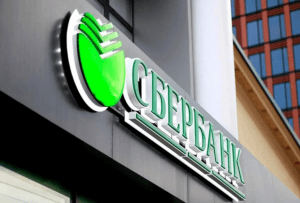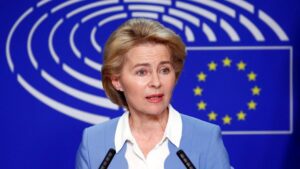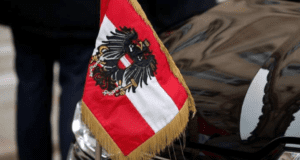
Ukraine has connected power unit No. 1 of the Khmelnytsky NPP to the power grid, as a result of which eight of the 15 existing power units are operating in the power system, the International Atomic Energy Agency (IAEA) reported, citing the Ukrainian nuclear regulator.
“Ukraine said one of the two units at the Khmelnytsky Nuclear Power Plant (NPP) had been reconnected to the grid after regulator maintenance,” according to the IAEA daily report on Ukraine on its website late on Wednesday.
As a result, eight of Ukraine’s 15 reactors are currently operating, including two at the Russian-controlled Zaporizhia NPP, three at the Rivne NPP, two at the Yuzhnoukrainsk NPP, and now one at the Khmelnytsky NPP.
“The seven other reactors are shut down for regular maintenance or held in reserve,” the agency said.
As reported, Ukraine stopped power unit No. 1 of the Khmelnytsky NPP on April 2, it remained in operation after power unit No. 2 was put into repair from February 18 for scheduled preventive repairs lasting approximately 92 days.
Before that, according to the IAEA, power unit No. 2 of the Rivne NPP was put out for repair.

The United States has included a number of Sberbank Group companies, including subsidiary banks in Ukraine and Kazakhstan, Cetelem Bank, bankrupt Sberbank Europe AG and payment service YooMoney, in its sanctions list, a statement from the U.S. Treasury Department’s Office of Foreign Assets Control (OFAC) indicated.
Sberbank Insurance, Sberbank Life Insurance, Sberbank Insurance Broker, Sberbank Leasing, Sberbank Factoring, NPF Sberbank, Sberbank-AST, Sberbank Capital, Sberbank CIB and Strategy Partners have also been included in the OFAC Specially Designated Nationals List (SDN List), as has United Credit Bureau, in which Sberbank holds a 50% according to the latest disclosure.
The SDN List now also includes Digital Technologies, a company through which Russia’s top bank invested in a range of information technology companies.
The United States on Wednesday imposed blocking sanctions against Sberbank that call for freezing assets in the U.S. and bar U.S. citizens from doing any business with the bank. The UK imposed similar sanctions against Sberbank.
The United States imposed correspondent and payable-through account sanctions against Sberbank in February 2022.

President of Ukraine Volodymyr Zelensky will meet with head of the European Commission Ursula von der Leyen on April 8, press secretary of the head of state Serhiy Nykyforov has said.
“There will be a meeting with European Commission President Ursula von der Leyen tomorrow. I can’t say the time for security reasons, but somewhere during the day,” Nykyforov said on the air of a nationwide telethon.
Earlier, the chief representative of the international organization, Eric Mamer, announced the visit of head of the European Commission Ursula von der Leyen to Kyiv this week.
Together with Ursula von der Leyen, head of European diplomacy Josep Borrell will also visit Kyiv.

The Ministry of Finance of Ukraine in March raised the forecast for payments on public debt in 2022 by UAH 4.93 billion compared to the March forecast – up to UAH 572.26 billion, according to the forecast for April on the agency’s website.
According to him, the largest amount of payments falls on April-June of this year – UAH 167 billion, while in August-September it is projected at the level of UAH 145.32 billion, in October-December – UAH 124.63 billion.
The Ministry of Finance estimates payments on domestic debt in 2022 at UAH 440.95 billion, and on external debt at UAH 131.32 billion.
According to the Ministry of Finance, on a monthly basis, the largest amount of payments fell on February – UAH 75.78 billion, and May – UAH 69.59 billion.
At the same time, the ministry increased the forecast of payments on public debt in 2023 by UAH 25.71 billion to UAH 400.91 billion.
In 2024, the ministry expects a payment in the amount of UAH 348.74 billion.

The Austrian authorities have decided to recognize “persona non grata” of four Russian diplomats, they must leave Austrian territory no later than April 12, the Oe24.tv portal reported on Thursday.
“The Austrian Foreign Ministry announced an order to deprive the diplomatic status of three employees of the Russian Embassy in Vienna and one employee of the Consulate General in Salzburg,” the portal notes.
According to the Austrian side, these diplomatic staff were engaged in activities incompatible with their diplomatic status, the portal notes.

Germany has already sent large volumes of weapons to Ukraine and is working to increase such supplies, the German Embassy reports, citing the German Defense Minister.
“Large volumes of weapons have already arrived in Ukraine from Germany. And we work hard every day to give her even more. Therefore, we are constantly in touch with the government of Ukraine […] But we do not talk about the details, for which there is a reason: Ukraine has clearly asked us about this, ”the embassy quotes the speech of German Defense Minister Christine Lambrecht in the Bundestag.